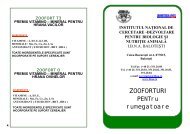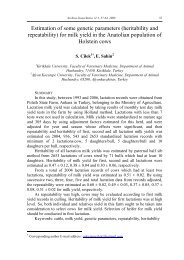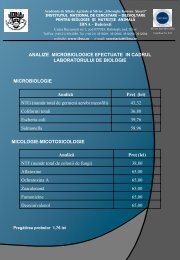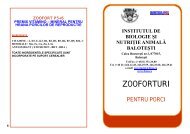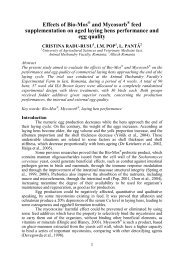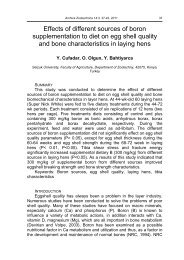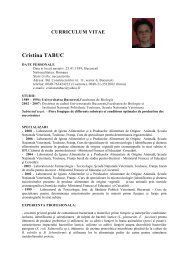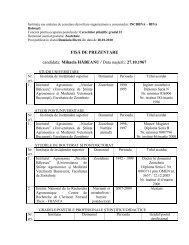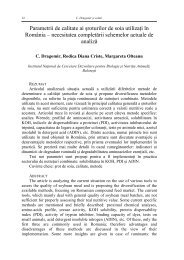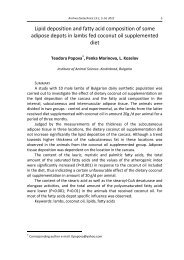(Coturnix coturnix japonica) during rearing and laying periods - IBNA
(Coturnix coturnix japonica) during rearing and laying periods - IBNA
(Coturnix coturnix japonica) during rearing and laying periods - IBNA
Create successful ePaper yourself
Turn your PDF publications into a flip-book with our unique Google optimized e-Paper software.
Analele <strong>IBNA</strong> vol. 26, 2010 77<br />
particular is improved. However the use of growth-promoting antibiotics is<br />
being placed under more <strong>and</strong> more Pressure as consumers increasingly fear that<br />
their use in feed rations of productive live stocks leads to the formation of<br />
resistance against bacteria which are pathogenic to humans (Langhout, 2000).<br />
Some prebiotics are an alternative to antibiotic to be used exclusively as a<br />
growth stimulant <strong>and</strong> for improvement of the feed conversion rate in farm<br />
animals (Esteive et al., 1997).A prebiotic compound was defined by Gibson <strong>and</strong><br />
Roberfroid(1995) as " a nondigestible feed ingredient that beneficially affect the<br />
host by selectively stimulating the grows <strong>and</strong>/or activity one or a limited<br />
number of bacteria in the colon <strong>and</strong> then improves got health. Whey can be used<br />
as a prebiotic. Lactose that is a major compound of whey, is a prebiotic but<br />
since poultry are lacking lactase (harms et al., 1997), lactose can not be digested<br />
or absorbed efficiently <strong>and</strong> almost reaches to ceca <strong>and</strong> large intestine intact<br />
(Langhout, 1989). In ceca, the population of useful bacteria likes lactobacillus<br />
<strong>and</strong> bifidobacteria (Zigger, 2000) increases <strong>and</strong> the pH of the GIT, due to<br />
increasing production of volatile fatty acids (VFAs), decreases. Therefore the<br />
environment of GIT becomes unsuitable for the activity <strong>and</strong> proliferation of<br />
pathogens like salmonella. On the other h<strong>and</strong>, a small decreasing in intestinal<br />
pH can improve nutrient digestibility. Studies with broiler chicks were indicated<br />
a positive response to dietary supplementation of prebiotic on nutrient<br />
digestibility (Biggs <strong>and</strong> parsons, 2007; Biggs, Parsons <strong>and</strong> Fahey, 2007).<br />
Kermanshahi <strong>and</strong> Rostami observed significant improvements in positive<br />
bacteria population for broiler chicks fed dried whey powder as a prebiotic. The<br />
review of literature showed that, fermentation of dried whey powder in the GIT<br />
produce CO2 that can be harmful for broiler. Fermented whey is a kind of whey<br />
that is fermented <strong>during</strong> producing process <strong>and</strong> can decrease the gas production<br />
in the intestine. Because of this, in the present study, we used two kinds of<br />
whey (fermented <strong>and</strong> dried whey powder) as new prebiotic on performance <strong>and</strong><br />
nutrient digestibility.<br />
MATERIAL AND METHODS<br />
In this study, totally 280, day-old Ross 308 chicks were used. The chicks<br />
were divided into 7 groups, 6 treatment groups <strong>and</strong> a control group, with 10<br />
chicks in each. Each group was housed separately in individual. Forty two<br />
stainless steel cages 40 × 65 × 98 cm were used to accommodate 10 chicks per<br />
m 2 . Plastic holed flooring was used as bedding. The chicks were fed st<strong>and</strong>ard<br />
starter (from 1 to 21 d), <strong>and</strong> grower (from 22 to 42 d) diets according to NRC<br />
(1994) (Table 1 <strong>and</strong> 2). Groups were r<strong>and</strong>omly assigned to following treatment<br />
groups, (1) Basal diet-no additives (control), (2) Basal diet + 1.5 % dried whey<br />
powder, (3) Basal diet + 3 % dried whey powder, (4) Basal diet + 4.5 % dried<br />
whey powder, (5) Basal diet + 1.5% fermented whey, (6) Basal diet + 3%<br />
fermented whey <strong>and</strong> (7) Basal diet + 4.5% fermented diet. Each experimental<br />
group was fed ad libitum with its own diet for 42 d. The temperature of the



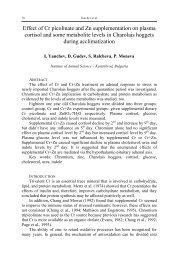
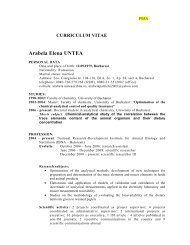
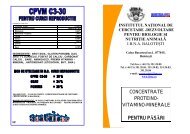
![( ) ( ) [ ] ( ) ( ) ( ) ( ) [ ]n ( ) ( ) [ ]n](https://img.yumpu.com/22443310/1/184x260/-n-n.jpg?quality=85)
